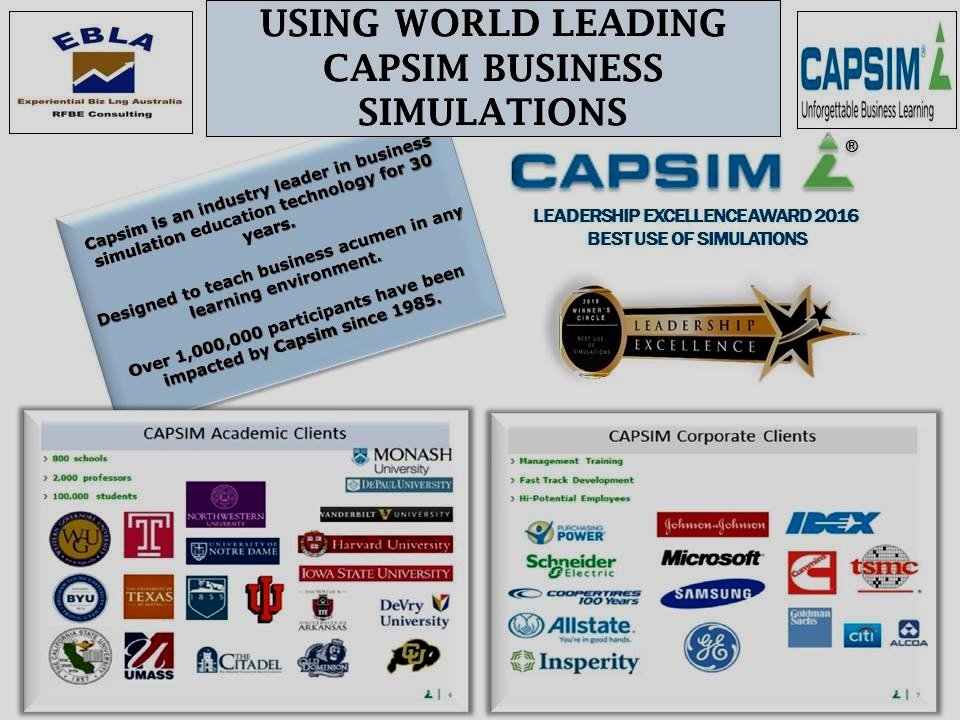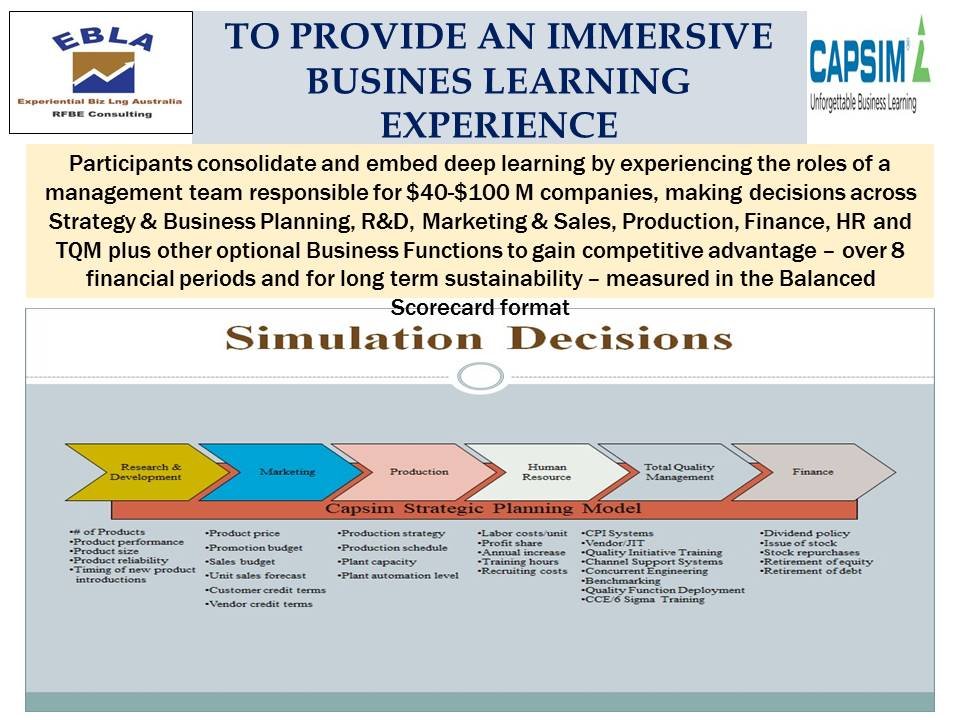
We Fast-track World Class Wholistic Business Management Capability -Applying a Unique and Proven 2 Step Approach
Step #1
Understanding Best Practice in Wholistic Business Management
Connecting and enhancing single subject theory into strong holistic business management understanding - referencing International and the Australian Business Excellence Framework which guides enterprises on best practice business principles, key dimensions, core practices, success factors and implementation approaches.
Step #2
Consolidating, Applying, Enhancing and Embedding Superior Wholistic Business Management Capability
Embedding this knowledge through digital age CAPSIM Experiential Business Learning Programs - providing a team-based, competitive, real-world and risk-free business learning experience - with the benefit of instantaneous and recursive balanced business results. World leading, digital age and highest impact Capsim Experiential Business Learning – is embedded as “ the future of business learning” in business education programs of leading Universities and Corporations globally.
What are the International Business Excellence Frameworks (BEF) ?
How do BEF’s benefit individuals and Employers ?
A Business Excellence Framework (“BEF”) is an overarching structured and systematic approach to the pursuit and application of the best appropriate way of doing things or relevant better practices and must be differentiated from specific business practice frameworks that focus on a particular area, for example, safety management, corporate governance, asset management or stakeholder management.
A BEF can also be described as an integrated leadership and management system that describes the elements essential to organisations sustaining high levels of performance. It can be used to assess and improve any aspect of an organisation, including leadership, strategy and planning, people, information and knowledge, safety, service delivery, product quality and bottom-line results. A BEF provides organisations with assurance of their sustainable performance and is a framework for leadership and governance.
BEF’s are used by hundreds of thousands of businesses worldwide and there are approximately 85 of these National Frameworks that are underpinned by the latest research, best practices and benchmarking both nationally and collectively through membership of a Global Excellence Management (GEM) Council. The most popular and influential model in the Western world is the Malcolm Baldrige National Quality Award Model (also known as the Baldrige model, the Baldrige Criteria, or the Criteria for Performance Excellence), launched by the US government. More than 60 national and state/regional awards base their frameworks upon the Baldrige criteria. Other leading BEF models include the EFQM Excellence Model (Europe), the Singapore Quality Criteria and Australia’s version, the Business Excellence Framework (Australia).
The Organisations that have leveraged BEF’s to most benefit have typically integrated the Business Excellence Approach into their corporate systems such as strategic planning and business performance management so that “it is the way they do things” and not something additional to normal business. BEF’s have been proven to bring about powerful changes in organisational performance and culture. Organisations using the BEF are able to develop business resilience and an integrated focus on sustainable performance.
Benefits that can accrue through the use of BEF’s include;
Effective prioritisation of your improvement efforts to deliver maximum benefits.
Process efficiency and effectiveness through reduced waste and variation.
Empowered and motivated workforce with increased retention.
Increased productivity and reduced operational costs.
Focus on customer service delivering superior perception of value.
Sustainable performance by increasing stakeholder value.
Additionally, the BEF provides an umbrella under which a number of business initiatives can be integrated to form one coherent, cohesive organisational systems model. Business initiatives that fit comfortably within the ABEF include: ISO 9001 series, Lean Six Sigma, Balanced Scorecard, Risk Management and Safety Management.
WHAT IS THE Australian Business Excellence Framework (ABEF)?
AUSTRALIAN BUSINESS EXCELLENCE FRAMEWORK (ABEF)
-
• The (ABEF) is the Australian version of the internationally recognised, leading holistic business management framework, guiding organisations that are committed to superior and sustainable business performance.
• The integrated leadership and management system that describes the elements essential to organisations sustaining high performance levels.
• It is used by enlightened organisations to assess, guide and improve all aspects of an organisation, including leadership, strategy and planning, information and knowledge, markets and customers, people, operational and business processes, and balanced business results.
-
1. CLEAR DIRECTION AND MUTUALLY AGREED PLANS ENABLE ORGANISATIONAL ALIGNMENT AND A FOCUS ON THE ACHIEVEMENT OF GOALS.
2. UNDERSTANDING WHAT CUSTOMERS AND OTHER STAKEHOLDERS VALUE, NOW AND IN THE FUTURE, ENABLES ORGANISATIONAL DIRECTION, STRATEGY AND ACTION.
3. ALL PEOPLE WORK IN A SYSTEM. OUTCOMES ARE IMPROVED WHEN PEOPLE WORK ON THE SYSTEM AND ITS ASSOCIATED PROCESSES.
4. ENGAGING PEOPLE’S ENTHUSIASM, RESOURCEFULNESS AND PARTICIPATION IMPROVES ORGANISATIONAL PERFORMANCE.
5. INNOVATION AND LEARNING INFLUENCE THE AGILITY AND RESPONSIVENESS OF THE ORGANISATION.
6. EFFECTIVE USE OF FACTS, DATA AND KNOWLEDGE LEADS TO IMPROVED DECISIONS.
7. VARIATION IMPACTS PREDICTABILITY, PROFITABILITY AND PERFORMANCE.
8. SUSTAINABLE PERFORMANCE IS DETERMINED BY AN ORGANISATION’S ABILITY TO DELIVER VALUE FOR ALL STAKEHOLDERS IN AN ETHICALLY, SOCIALLY AND ENVIRONMENTALLY RESPONSIBLE MANNER.
9. LEADERS DETERMINE THE CULTURE AND VALUE SYSTEM OF THE ORGANISATION THROUGH THEIR DECISIONS AND BEHAVIOUR.
-
1.0 Leadership
1.1 Leadership and governance throughout the organisation
1.2 Leading the organisational culture
1.3 Society, community and environmental responsibility
2.0 Strategy and Planning
2.1 Strategic direction
2.2 The planning process
3.0 Information and Knowledge
3.1 Generating, collecting and analysing the right data to inform decision-making
3.2 Creating value through applying knowledge
4.0 People
4.1 A great place to work
4.2 Building organisational capability through people
5.0 Customers and other Stakeholders
5.1 Gaining and using knowledge of customers and other stakeholders
5.2 Effective management of customer and other stakeholder relationships
5.3 Customers and other Stakeholders" perception of value
6.0 Process Management, Improvement and
Innovation
Results and
Sustainable
Performance
8.1 Identification and management of proces5e5
8.2 Process improvement and innovation
7.1 Measuring and communicating organisation al results
7.2 Achieving sustainable performance
What Is Digital Age Experiential Business Learning and CAPSIM?
CAPSIM IS THE WORLD LEADER IN DIGITAL AGE BUSINESS SIMULATIONS THAT HAVE BEEN DESIGNED ——
It has long been acknowledged, by universities and corporations that effective business learning must incorporate the following:
-
Action-based problem solving in real world business conditions (traditionally internships and on the job training).
-
Developing integrated hard business and key soft skills such as leadership, teamwork, awareness & emotional intelligence.
-
Practical understanding based on testing decisions, reviewing and responding to results.






